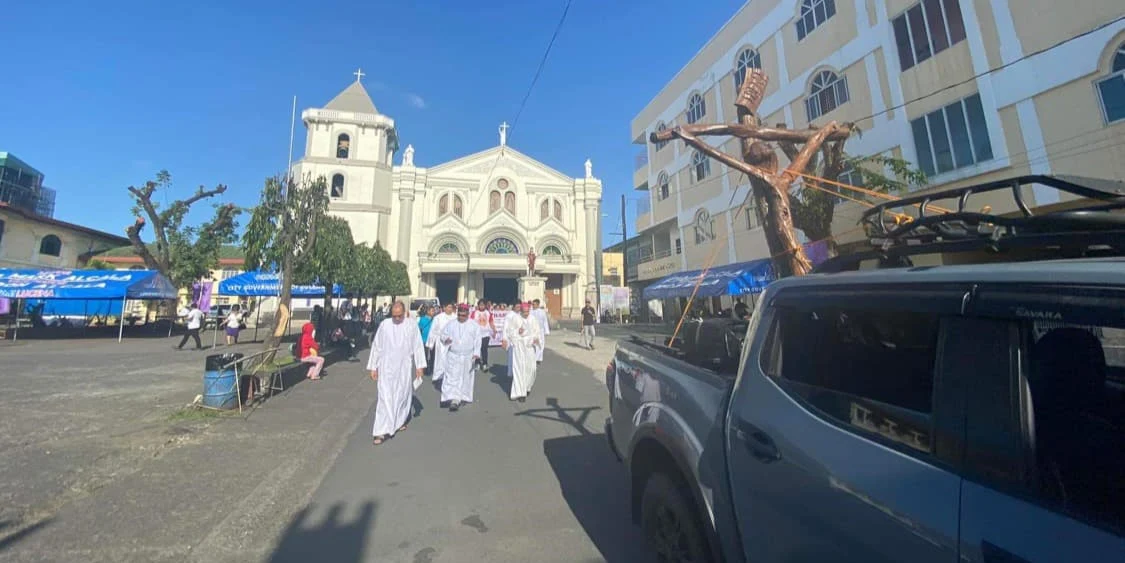By Nimfa Estrellado Bearing the revered "Krus ng Sierra Madre", Catholic leaders in Quezon province marched through Lucena City on...
LUCENA CITY, Quezon – Religious leaders from the Diocese of Lucena and the Prelature of Infanta engaged in a constructive dialogue with the Quezon Provincial Council on March 25, 2024 regarding the controversial Kaliwa Dam Project. Vice Governor Anacleto Alcala III acknowledged that further studies are needed to fully assess the project's potential impact on indigenous rights.
Father Warren Puno, Ecology Desk director for the Lucena Diocese, highlighted concerns raised by the Dumagat-Remontado people of General Nakar. The parties involved have agreed to compile an affidavit documenting alleged violations by the Metropolitan Waterworks and Sewerage System (MWSS) and the National Commission on Indigenous Peoples (NCIP).
The Quezon Provincial Government has committed to a committee hearing on April 4, 2024, where environmental risks posed by the dam will be further evaluated with the input of a geologist. An official statement assures affected communities that the government will prioritize transparent communication and the swift resolution of the matter.
Father Puno also questioned the necessity of additional LNG power plants in Quezon, given its existing coal-fired infrastructure. He proposed alternative development locations, emphasizing that the province should not be the sole host for such projects. These concerns are expected to be addressed in future dialogues.
Project continues despite protest
The China-funded Kaliwa Dam, intended to provide Metro Manila with 600 million liters of daily water, is currently 30% complete, according to the MWSS. Despite delays due to environmental and indigenous community displacement concerns, the MWSS and its partners aim to complete the dam project by 2027. Commissioning is scheduled to begin in the second quarter of 2028.
Constructed on the Kaliwa River, the 60-meter-high concrete gravity dam will create a reservoir with a 291-hectare surface area. It boasts a maximum volume of 57 million cubic meters and a 600-million-liter daily discharge capacity.
Initiated under former President Duterte's "Build, Build, Build" infrastructure program, the Kaliwa Dam remains a priority for the Marcos administration's "Build, Better, More" scheme. It is seen as a crucial long-term solution to offer redundancy to the Angat Dam, currently Metro Manila's primary water source.
The commissioning of the Kaliwa Dam is scheduled to begin within the second quarter of 2028. The 60-meter-high concrete gravity dam is being constructed on the Kaliwa River. It will feature a 291-hectare reservoir surface area, a maximum gross reservoir volume of 57 million cubic meters, and a daily discharge capacity of 600 million liters.
The project faces ongoing protests. Concerns center around negative environmental impacts like the displacement of indigenous communities and the potential destruction of wildlife habitats. Despite these protests, the government remains committed to the dam's completion, citing Metro Manila's growing water needs as justification.
The Sierra Madre, Luzon's imperiled backbone
Spanning over 540 kilometers along Luzon's eastern spine, the Sierra Madre mountain range is the Philippines' longest and a treasure trove of biodiversity. Its ancient forests harbor a dazzling array of life, from the majestic Philippine Eagle to countless species yet to be discovered. It also safeguards the island as a watershed guardian, regulating its vital rivers and shielding it from typhoons.
This natural fortress faces imminent peril from the Kaliwa Dam project, the first in a network of large dams planned for the region. "Greenpeace believes that pursuing this project is an atrocious move, particularly at a time of worsening climate crisis," says Greenpeace Philippines campaigner Rhea Jane Mallari.
The dam would submerge vital portions of the Sierra Madre, destroying precious ecosystems and endangering communities that depend on them for livelihood, culture, and protection. It also risks magnifying existing social injustices.
The Sierra Madre's dense forests act as a vast natural sponge, regulating the flow of vital river systems that sustain millions of people. The Kaliwa Dam threatens to disrupt this delicate watershed balance, potentially causing flooding and displacing indigenous communities.
"The Fight for the Future is a battle against shortsighted decisions that prioritize short-term gains over long-term sustainability," Mallari emphasizes. "It is imperative that we consider the interconnectedness of ecosystems and the impact of our actions on both the environment and vulnerable communities,” she added.









CLARIFICATION: There is no violation committed by the NCIP here, there is a vague misinterpretation of the FPIC process that makes the anti-Kaliwa Dam believe to their supporters/followers. Meanwhile, the MWSS has complied to the FPIC process and consulted the indigenous peoples for more than seven (7) years. Seven years is obviously not a shortcut nor a railroading of the FPIC process rather it is a meticulous and sensitive approach to address the environmental, social, cultural and economic concerns of the IPs. Lastly, the church and NGOs do not have the authority to represent the IPs, this have been expressed by the Dumagat/Remontado ICC/IPs themselves.
ReplyDelete